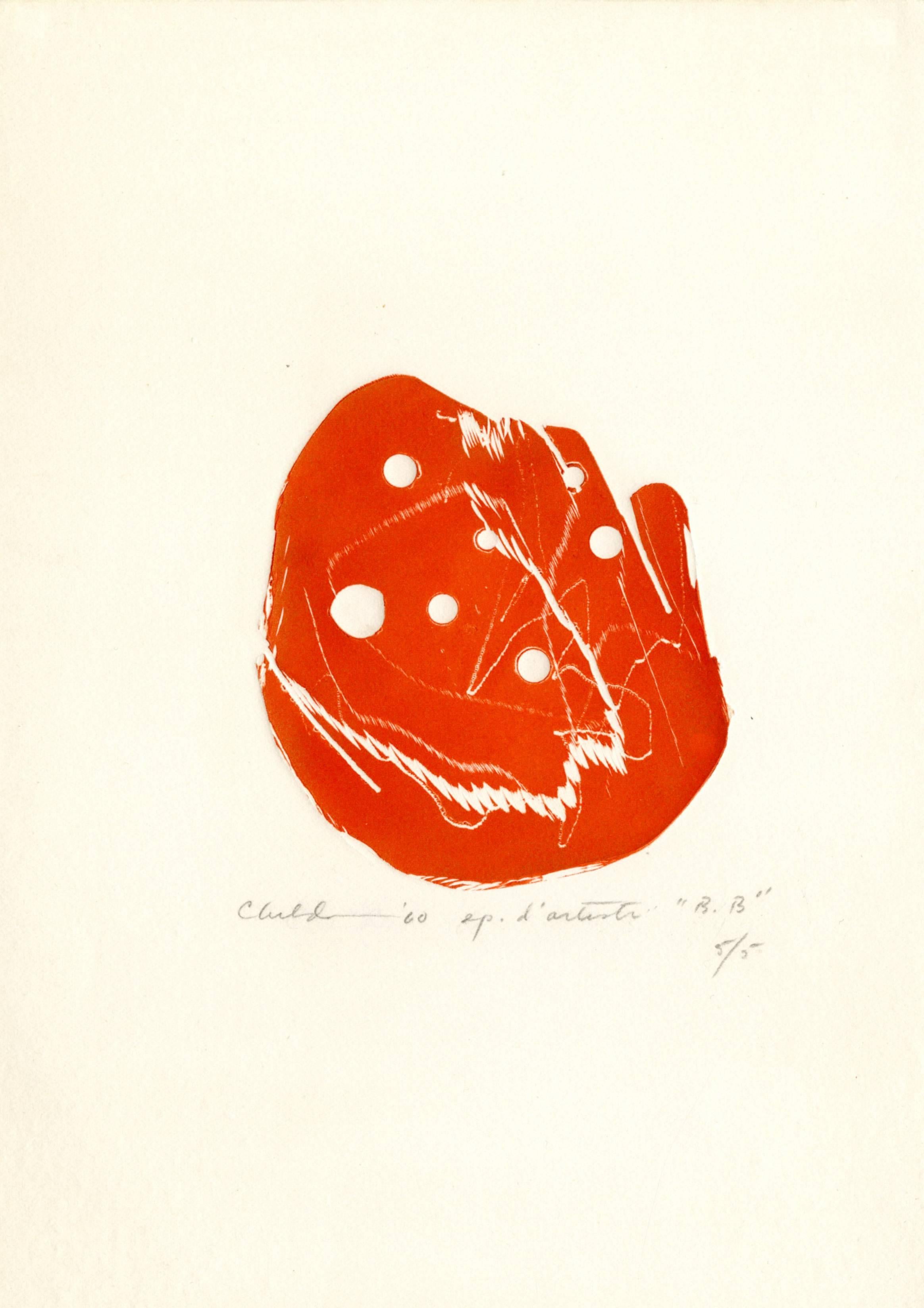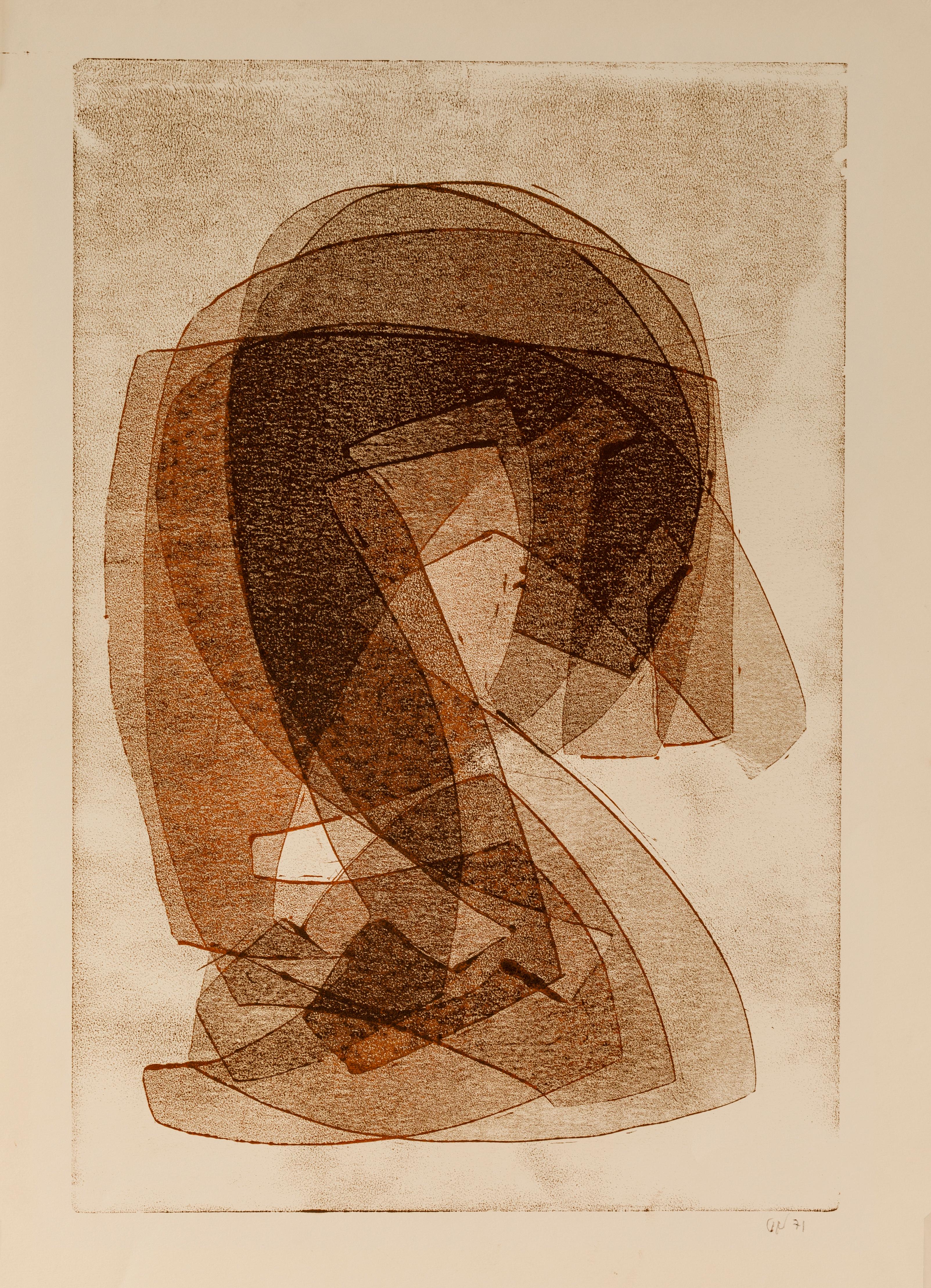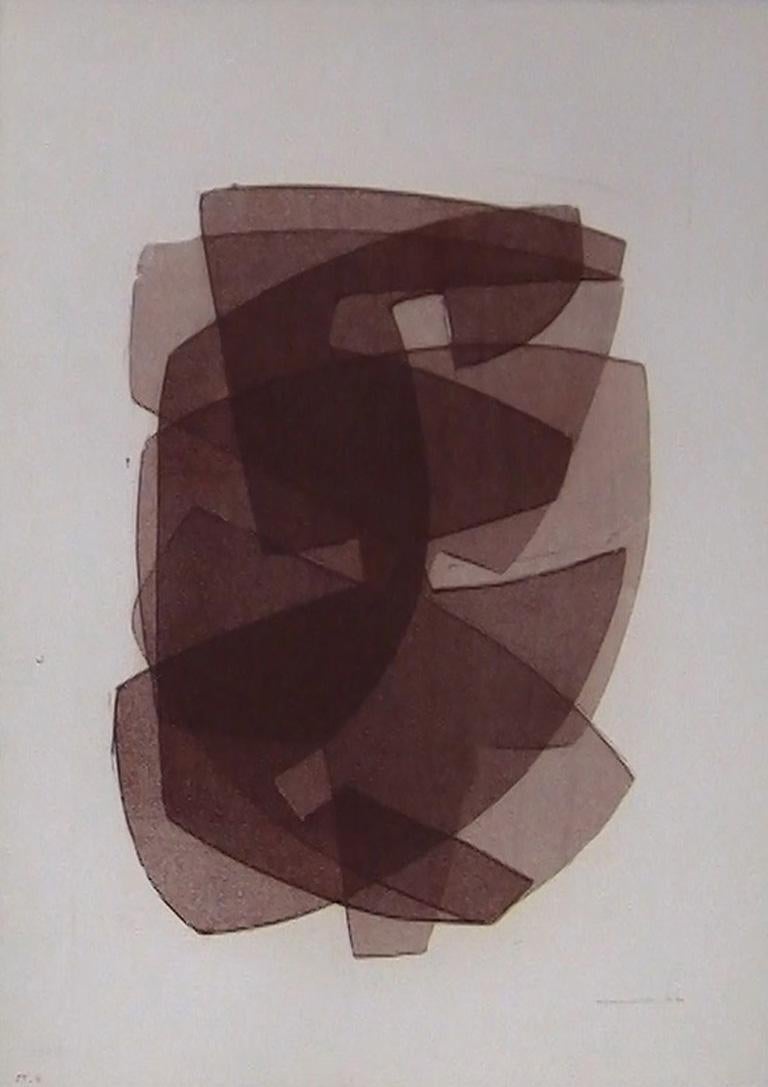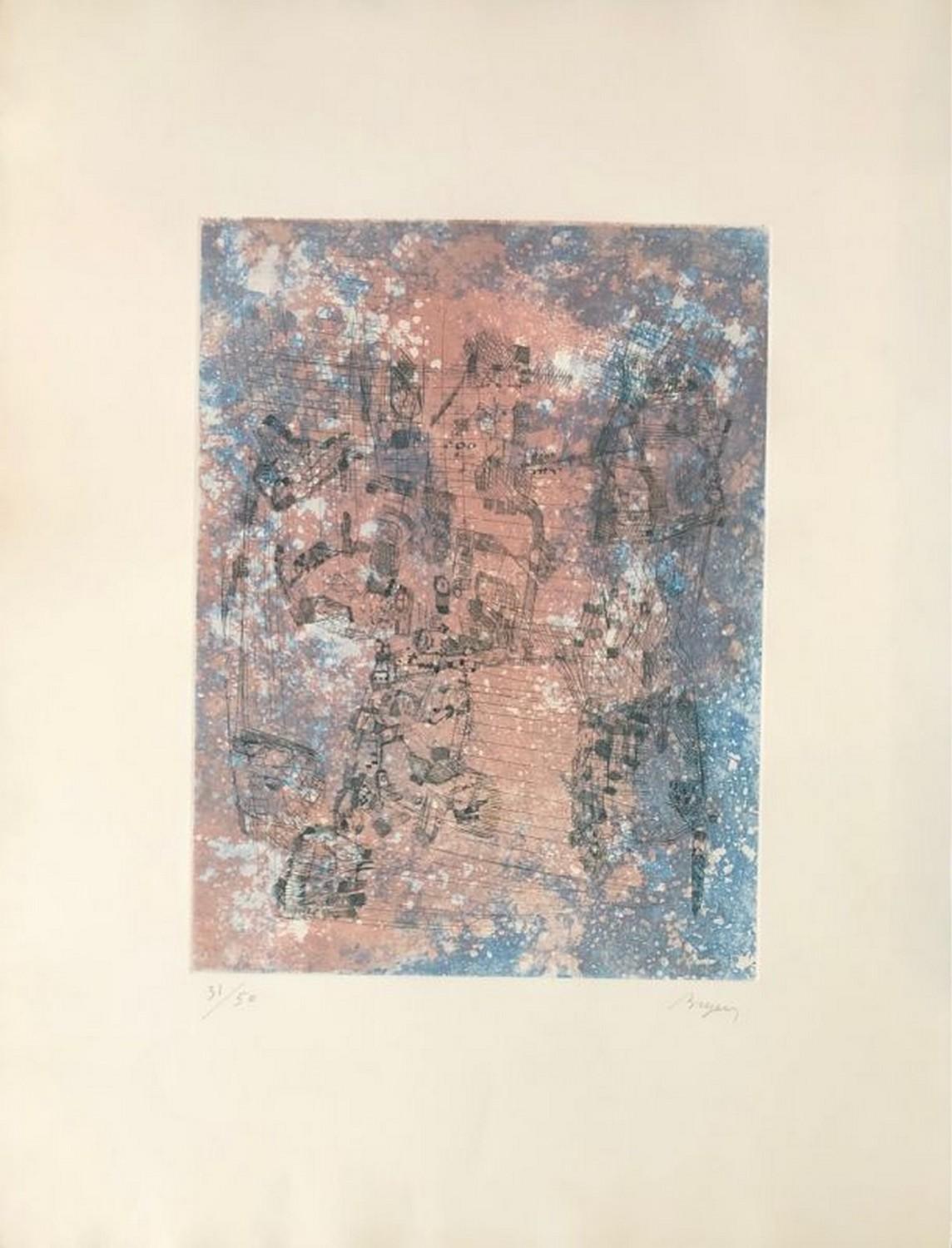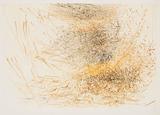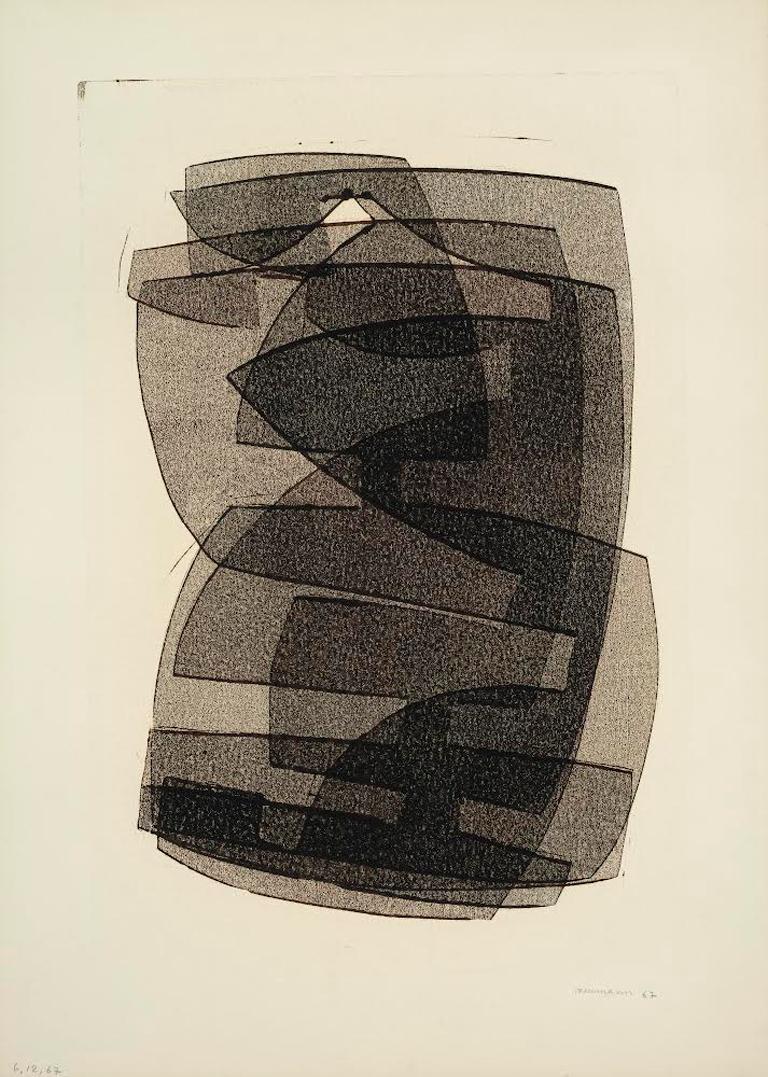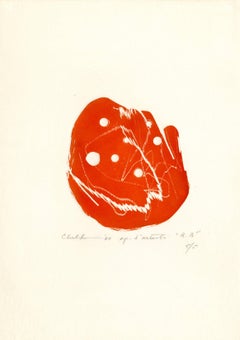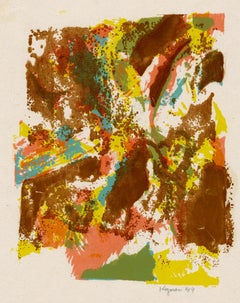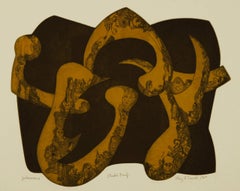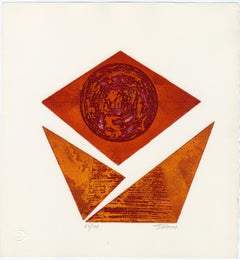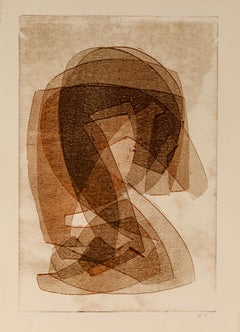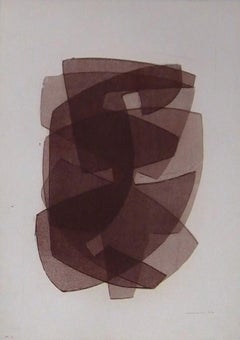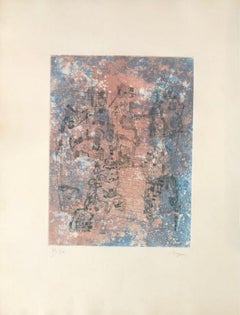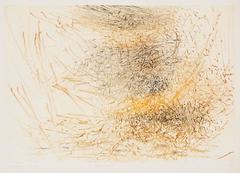Want more images or videos?
Request additional images or videos from the seller
1 of 2
Bernard ChildsB.B.1960
1960
$800
£619.93
€703.49
CA$1,146.61
A$1,259.20
CHF 648.19
MX$15,066.69
NOK 8,252.86
SEK 7,734.16
DKK 5,253.97
About the Item
Signed, dated, annotated "epreuve d'artiste"; Annotated on titled "B.B."
Edition: 5 (5/5)
Part of a set of 4 prints commissioned for a book Childs did with the German writer Bazon Brock entitled D.A.S.E.R.S.C.H.R.E.C..E.N.A.M.S. published by Panderma Verlag Laszlo in Basel in 1960. The engravings were created by the artist using power tools to cut and engrave the copper plate includuing rotary burrs, drills, saws. They were then printed on Childs' press in Paris by the Dutch artist Nono Reinhold, typically in an orangy red ink, although some metallic ink shows up in a few trial proofs and studies. This impression is one of five sets that were kept by Childs who signed and numbered them 1/5 to 5/5.
Bernard Childs (1910-1985)
Bernard Childs (1910–1985) was an artist who worked in Paris and New York. He was primarily a painter and printmaker, and pioneered the direct engraving of metal plates with power tools. As a kind of counterpoint to his many-layered work, which is often symbolic and a fusion of abstraction and figuration, in 1959 he also started painting portraits. Childs' formal interests were line and space, light and color, and the dialogue of contrasting elements.
Life
Childs wrote, "My work is to make pictures." He first found his vocation in high school, in Harrisburg, Pennsylvania where his Russian immigrant parents had moved the family from his birthplace, Brooklyn. During her last days, his mother told him he was the seventh generation of artists in the family, his forebears having been painters of icons in the churches of Yaroslav.
In 1928, a scholarship took him to the University of Pennsylvania. He left two years later for New York where he worked by day and studied at night with Kimon Nicolaїdes at The Art Students League in New York. He also had the luck to meet the great Danish silversmith Peer Smed, from whom he learned his love of metal.
The economic and social problems of the 1930s took Childs away from his work as an artist, until he began drawing again in the South Pacific while serving as a quartermaster aboard the destroyer escort USS Wesson, during World War II. Childs survived a Kamikaze attack and, at war's end, two years of intermittent hospitalization after returning to New York. His recovery was complete by 1947, the year he studied with Amédée Ozenfant, who became a good friend. In 1951, thanks to the G.I. Bill, he sailed for Italy where he began his full-time life as an artist. It was there that he met and became friends with Alberto Burri and Enrico Baj.
Following a year in Perugia and in Rome and his first solo exhibition, at the venerable Galleria dell'Obellisco, Childs settled in Paris, realizing his first mature painting at age 42 and quickly becoming part of the European vanguard. He was included in many exhibitions of the Paris salons, various galleries such as Ariel and Iris Clert, Galerie Parnass in Wuppertal and the free floating group Phases along with Alechinsky, Baj, Cousins, Ernst, Fahlström, Fontana, Lam, Jaffe, Pederson, Soulages, Yasse Tabuchi, and Tajiri. He was championed by the French art critics Pierre Restany and Édouard Jaguer, and the Swedish art historian and curator Ragnar von Holten.
By 1959 he was in Documenta II and had his first solo museum exhibition, of paintings and prints, at the Stedelijk Museum in Amsterdam. It was in early 1955, after a month in December 1954 at Atelier 17, that he had signed his first editions of prints and begun pioneering the direct engraving of metal plates with power tools for which he is well recognized. Childs was also one of the first post World War II Western artists invited to show in Japan where he had two exhibitions, of paintings and of prints in 1960 and 1961 respectively at the Tokyo Gallery, and received the Museum of Western Art Award at the 1961 Tokyo International Print Biennial.
From 1966 to 1977, Childs commuted between his Paris studio and his New York studio at the Hotel Chelsea. In 1969, a retrospective of his 1960's paintings, prints and engraved acrylic light sculptures was held at the Storm King Art Center in Mountainville, NY. This exhibition was the occasion for the first public view of his light sculptures – laminates of engraved sheets of acrylic lit from below – an experiment with light and color that he began the same year and continued through part of the 1970s.[2] Although a stroke in 1978 interrupted his career, Childs never stopped drawing and soon resumed painting, remaining in New York until his death at age 74 in March 1985.
Although he exhibited extensively in group shows, Childs was essentially a loner. A renowned curator once called him a "rogue artist", one who cannot be defined by a category, a group, or a decade. Often a fusion of abstraction and figuration, at times paralleled by portraiture, his is a body of work rooted in the second half of the 20th century and whose ongoing appeal defies time.
Formal interests and underlying stories
Underlying Childs' art is a story of survival – of war, of environmental disaster – expressed with consummate craftsmanship and an ever renewed search and invention in many mediums. Ancient insect species became a favorite symbol of survival.[3] He drew their movements and strength up close and even sent them in his 1970's paintings to explore outer space for a new home, should planet Earth no longer support life. Survival of the planet and above all, survival of life in no matter what form it took, was a big concern. Creation myths, world myths, certain literary myths were close to his heart.
Childs' formal concerns were line and space, light and color, and the dialogue of contrasting elements related in time but often projecting different spatial environments. Portraiture and figuration of one kind or another are ever present, overtly or woven into abstractions. Childs took a sensual pleasure in his materials and a sensual, witty approach to many of the visual stories he told. His erotic stories of love are tender and sometimes funny. Danger is reflected in both his memories of war and his warnings of future dangers such as nuclear holocaust.
Selected public collections
• Bibliothèque nationale de France, Paris
• Ishibashi Foundation, Tokyo (formerly the Bridgestone Gallery)
• Brooklyn Museum, Brooklyn, New York
• Grey Art Gallery, New York University, New York
• Hood Museum of Art, Hanover, New Hampshire
• Israel Museum, Jerusalem
• Metropolitan Museum of Art, New York
• Museum of Fine Arts, Boston
• Moderna Museet, Stockholm
• National Portrait Gallery, Stockholm
• National Portrait Gallery, Washington, DC
• The National Museum of Western Art, Tokyo
• Princeton University Museum of Art, Princeton, New Jersey
• San Francisco Fine Arts Museums, Palace of the Legion of Honor, Achenbach Foundation for Graphic Arts
• Smith College Museum of Art & the Mortimer Rare Book Room, Northampton, Massachusetts
• Stedelijk Museum, Amsterdam
• The Hyde Collection, Glens Fall, New York
• The Library of Congress, Washington D.C.
• The Butler Institute of American Art, Youngstown, Ohio
• The Jane Voorhes Zimmerli Art Museum, Rutgers, New Brunswick, New Jersey
• Whitney Museum of American Art, New York
• Worcester Art Museum, Worcester, Massachusetts
• Yale University Art Museum, New Haven, Connecticut
• The Harvard Art Museums, Cambridge, Massachusetts
- Creator:Bernard Childs (1910 - 1985, American)
- Creation Year:1960
- Dimensions:Height: 11.13 in (28.28 cm)Width: 7.88 in (20.02 cm)
- Medium:
- Movement & Style:
- Period:
- Condition:Printed on Arches paper.
- Gallery Location:Fairlawn, OH
- Reference Number:Seller: FA96311stDibs: LU1401532583
About the Seller
5.0
Recognized Seller
These prestigious sellers are industry leaders and represent the highest echelon for item quality and design.
Gold Seller
Premium sellers maintaining a 4.3+ rating and 24-hour response times
Established in 1978
1stDibs seller since 2013
824 sales on 1stDibs
Typical response time: <1 hour
Associations
International Fine Print Dealers Association
- ShippingRetrieving quote...Shipping from: Fairlawn, OH
- Return Policy
More From This Seller
View AllUntitled
By Bernard Childs
Located in Fairlawn, OH
Signed, dated, annotated "epreuve d'artiste"; Annotated on titled "B.B."
Edition: 5
References And Exhibitions:
One of the three impressions printed on ARCHES watermark paper
Int...
Category
1950s Abstract Abstract Prints
Materials
Intaglio
Untitled
By Myron Kozman
Located in Fairlawn, OH
Untitled
Screen print, 1941
Signed and dated in pencil lower right
From an unnumbered edition of 6
Condition: Excellent
Image size: 7 1/4 x 5 3/4 inches
Sheet size: 10 x 8 inches
Pr...
Category
1940s Abstract Abstract Prints
Materials
Screen
Jedermann
By Ray H. French
Located in Fairlawn, OH
Etching in two colors
Signed, dated, titled in pencil by the artist
Sheet size: 19 5/8 x 25 3/4"
Category
1950s Abstract Prints
Materials
Etching
Untitled (Plate 3)
By Terry Haass
Located in Fairlawn, OH
From: Happy Pentagone (6 plates)
Signed and numbered in pencil
Edition: 100 (37/100)
Printer: Lacouriere et Frelaut Imprimeur, Paris
Paper: BFK RIVES watermark on some sheets from th...
Category
1970s Abstract Abstract Prints
Materials
Etching
Untitled (Plate 3)
By Terry Haass
Located in Fairlawn, OH
From: Happy Pentagone (6 plates)
Signed and numbered in pencil
Edition: 100 (37/100)
Printer: Lacouriere et Frelaut Imprimeur, Paris
Paper: BFK RIVES watermark on some sheets from th...
Category
1970s Abstract Abstract Prints
Materials
Etching
Untitled (Plate 3)
By Terry Haass
Located in Fairlawn, OH
From: Kaleidoscope (6 plates)
Signed and numbered in pencil
Edition: 100 (3/100)
Printer: Lacouriere et Frelaut Imprimeur, Paris
Paper: BFK RIVES watermark on some sheets from the se...
Category
1970s Abstract Abstract Prints
Materials
Aquatint
You May Also Like
Estate No. 096009
By Otto Neumann
Located in New Orleans, LA
Otto Neumann (1895-1975) was an expressionist painter and printmaker born in Heidelberg, Germany. He was one of the most versatile and original artists of the twentieth century. Neum...
Category
1970s Abstract Abstract Prints
Materials
Monotype
Estate No. 082031
By Otto Neumann
Located in New Orleans, LA
Otto Neumann (1895-1975) was a German Expressionist painter and printmaker. His monotypes evolved from sharp, angular, black and whites to late abstract prints in a variety of colors. Neumann lived through revolutionary changes in the art world of prewar and postwar Germany. He was a prolific artist in Germany during a time of the country’s unprecedented academic and intellectual growth. His early work shows the influence of both French masters like Cezanne and the contemporary style that was then being developed by German Expressionists like Kirchner. A master printmaker, Neumann was also inspired by the works of Albrecht Durer, whose allegorical subject-matter and unmatched drawing technique Neumann would emulate throughout his career. A lifetime preoccupation with the human figure informs his work, with frieze-like human figures recalling ancient Greek art...
Category
1960s Expressionist Abstract Prints
Materials
Monotype
No title
By Camille Bryen
Located in Paris, FR
Engraving
Handsigned by the artist in pencil and numbered 31/50
66.00 cm. x 50.00 cm. 25.98 in. x 19.69 in. (paper)
39.00 cm. x 29.50 cm. 15.35 in. x 11.61 in. (image)
LCD4237
Category
1970s Abstract Abstract Prints
Materials
Engraving
Frumente
By Bernard Childs
Located in Dallas, TX
edition 19/200
signed "Childs '55 (c)" at lower left
paper size is 17 3/4 x 22 1/4 inches
mat size is 20 x 24
Category
Mid-20th Century Abstract Abstract Prints
Materials
Etching
Estate No. 082126
By Otto Neumann
Located in New Orleans, LA
Otto Neumann (1895-1975) was an expressionist painter and printmaker born in Heidelberg, Germany. He was one of the most versatile and original artists of...
Category
1960s Expressionist Abstract Prints
Materials
Monotype
Estate No. 082024
By Otto Neumann
Located in New Orleans, LA
Otto Neumann (1895-1975) was an expressionist painter and printmaker born in Heidelberg, Germany. He was one of the most versatile and original artists of the twentieth century. Neum...
Category
1960s Expressionist Abstract Prints
Materials
Monotype
